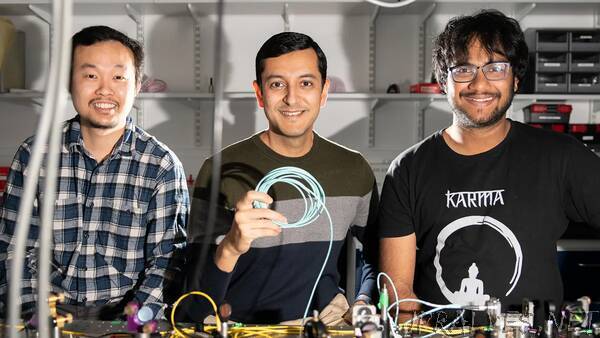
“Scientists at Heriot-Watt University have found a powerful new way to programme optical circuits that are critical to the delivery of future technologies such as unhackable communications networks and ultrafast quantum computers.
“Light can carry a lot of information, and optical circuits that compute with light – instead of electricity – are seen as the next big leap in computing technology,” explains Professor Mehul Malik, an experimental physicist and Professor of Physics at Heriot-Watt’s School of Engineering and Physical Sciences.
“But as optical circuits get bigger and more complex, they’re harder to control and make – and this can affect their performance. Our research shows an alternative – and more versatile – way of engineering optical circuits, using a process that occurs naturally in nature.”
Professor Malik and his team conducted their research using commercial optical fibres that are widely used around the world to transport the internet to our homes and businesses. These fibres are thinner than the width of a human hair and use light to carry data.
By harnessing the natural scattering behaviour of light inside an optical fibre, they found they could programme optical circuits inside the fibre in highly precise ways.
The research is published today in the prestigious scientific journal Nature Physics.
“When light enters an optical fibre, it gets scattered and mixed in complex ways,” Professor Malik explains. “By learning this complex process and precisely shaping the light that enters the optical fibre, we’ve found a way to carefully engineer a circuit for light inside this disorder.”
Optical circuits are critical to the development of future quantum technologies – which are engineered on a microscopic level by working with individual atoms or photons – particles of light. These technologies include powerful quantum computers with immense processing power and quantum communications networks which can’t be hacked.
“Optical circuits are needed at the end of quantum communications networks, for example, so the information can be measured after it’s travelled long distances,” Professor Malik explains. “They are also a key part of a quantum computer, where they are used for performing complex calculations with particles of light.”
Quantum computers are expected to unlock big advances in areas including drug development, climate prediction and space exploration. Machine learning – artificial intelligence – is another area where optical circuits are used to process vast volumes of data very quickly.
Professor Malik said the power of light was in its multiple dimensions.
“We can encode a lot of information on a single particle of light,” he explained. “On its spatial structure, on its temporal structure, on its colour. And if you can compute with all of those properties at once, that unlocks a massive amount of processing power.”
The researchers also showed how their programmable optical circuits can be used to manipulate quantum entanglement, a phenomenon when two or more quantum particles – such as photons of light – remain connected even when they’re separated by vast distances. Entanglement plays an important role in many quantum technologies, such as correcting errors inside a quantum computer and enabling the most secure types of quantum encryption.
Professor Malik and his research team in the Beyond Binary Quantum Information Lab at Heriot-Watt University conducted the research with partner academics from institutions including Lund University in Sweden, Sapienza University of Rome in Italy and the University of Twente in The Netherlands.
The research was funded by QuantERA, a leading European network of 39 public Research Funding Organisations (RFOs) from 31 countries; the Austrian Research Promotion Agency (FFG) – Austria’s national funding agency for industrial research and development – and the European Research Council (ERC) – the European Union’s funding organisation for frontier research.”
